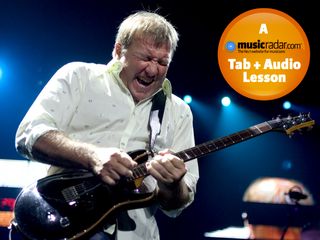Rush have now been active for over 40 years, having formed in 1968 in Canada by guitar player Alex Lifeson alongside vocalist and bass player Jeff Jones and John Rutsey on drums.
Jones was replaced by Geddy Lee almost immediately and in1974 Rutsey was replaced by Neil Peart. Thus the band's classic line-up was born and is still going strong today.
Unlike most bands, it is drummer Peart who is the principal lyricist, with Lifeson and Lee writing the music. They may not be a household name in the way that AC/DC, Queen or Pink Floyd are, but Rush have released 19 studio albums which have shifted some 40 million units and have inspired countless other bands including Iron Maiden and Dream Theater
The early years saw Rush release some classic progressive rock albums such as 2112 and Hemispheres during the '70s before delving into other genres such as reggae and the more synthesiser based 'classic rock' in the '80s with Power Windows and Hold Your Fire.
Alex Lifeson's playing has always been understated yet highly technical and it isn't until you start to analyse what's going on in Rush's music that you realise how complex a lot of it really is.
Time sig changes
The track in this lesson moves through many different time signatures, which is something that most rock guitar players don't really look at in much detail. We start in 7/4 and then visit 3/4, 2/4, 6/4 and 4/4. It's all diatonic to D minor (D E F G A Bb C) but will take some very precise playing to really nail every part of it properly.
There's plenty of space for the instruments to interact with each other and get the best of the 'power trio' format. The guitar player, bass player and drummer will need to really be listening to what's going on to avoid getting in each other's way.
There is some heavy syncopation in the rhythm guitar part, which is a nod towards some of the more reggae-influenced music that Rush released in the '80s, as well as a lot of arpeggiated chords and phrases throughout. Then, once we get to the lead guitar part, it's back to 4/4 and some good old rocking out.
Lifeson tends to use his whammy bar for a lot of the vibrato that he adds, so all the phrases on the solo with vibrato on this track are played using the bar. The solo uses a number of staccato (short notes) phrases, as well as some legato and wide stretches. See the playing tips for further instruction.
Many thanks to Mark Prentice for doing a great impression of Geddy Lee on the bass in the audio.
Audio
Full track
Backing track
Next page: tab for the audio example
Example: Rush-style rhythm

(Click tab to enlarge)
[From bar 1] Make sure you really pay attention to the phrasing of the oddly metered bars. For 7/4 you can hear it being split into 4 and 3. Playing cleanly is the name of the game here.
[From bar 8] Be careful here - you want to get the syncopated phrases in time throughout. The repeated double-stop phrase in bars 12 and 19 gives a Lydian sound due to the E (#4 interval) over the Bb chord.
Example: Rush-style rhythm continued

(Click tab to enlarge)
Next page: Rush-style lead tab
Example: Rush-style lead

(Click tab to enlarge)
[Bars 35 and 37] This phrase has quite a wide stretch. It's just a D minor pentatonic phrase, but by dipping into two diferent shapes (shapes 1 and 2), it sounds diferent to a lot of other pentatonic phrases you're likely to hear in blues and rock.

